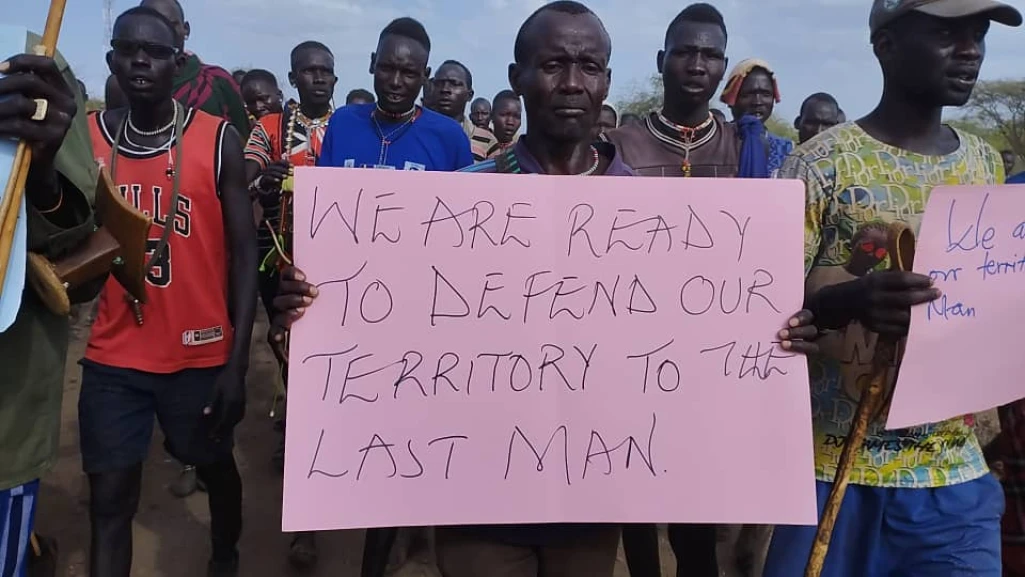
Residents of Kapoeta East hold peaceful protests against presence of Kenyan soldiers in the area on Wednesday, February 1, 2023 | Credit | Courtesy
The Toposa Community is rejecting Kenya’s request to construct the
11-kilometre Nadapal-Nakodok road.
On Wednesday this week, Kenyan President William Ruto arrived in Juba on an
official visit to enhance bilateral relations between the two countries.
In a ‘Joint Communique on the Occasion of the Official Visit to Juba by H.E.
William Ruto, President of the Republic of Kenya on 6th November
20244,’ The two heads of state noted that Kenya and South Sudan share strong
historical ties, built on fraternal bonds, and are committed to bolstering
bilateral relations.
Henceforth, discussing infrastructure development and particularly the
construction of the 11-kilometre Nadapal-Nakodok road, the two heads of state
noted that it is a vital cross-border infrastructure crucial for enhancing
trade and movement between the two countries.
The road will not only benefit economies but also strengthen the ties
between the two countries.
However, following this development discussion and plan, the Toposa
Community Union in Eastern Equatoria voiced their rejection.
Paul Napwon Yonae, the Chairperson of Toposa Community Union, Kapoeta,
Eastern Equatoria State, says the entire Toposa Community in Eastern Equatoria
State, South Sudan, and in the Diaspora across the world rejects the request of
the Kenyan President and directives of the two Heads of State directing their
respective Ministers responsible for Roads to undertake discussions immediately
with the World Bank regional office in Nairobi and agree on the way forward.
It was noted that Kenya secured a World Bank financing facility that was set
to expire on November 8, 2024.
“We reject any attempt to allow the Republic of Kenya to extend the
construction of the road from Nadapal to Nakodok. Kenya is claiming the 11 KM
Nadapal-Nakodok as part of their Al road infrastructure, contrary to the
international boundary delimited in 1902 and the 1914 Order of the Uganda
Council,” the press release seen by The Radio Community read.
The Toposa Community says Kenya is making a claim over an 11-kilometre
stretch of land between Nadapal and Nakodok and parts of the South Sudanese
territory, disregarding the Order of the Secretary of State No. 241 of 1914,
the Uganda Order in Council 1902, which the Republic of South Sudan and the
Republic of Kenya have agreed as the basis for the delimitation and demarcation
of the border between the two countries.
“South Sudan is a sovereign country, and hence, Kenya cannot secure a loan
or grant from the World Bank to develop the infrastructure in the South Sudan
Territory. We urge the two governments to commit to the implementation of the
signed MOU for a final delimitation and demarcation of the boundary between the
two counties on June 17, 2019.”
In addition, the Toposa Community Union says that by providing Kenya with a
financing facility to construct road infrastructure on claimed land by Kenya,
the World Bank Financing Facility is complicit to the Kenyan illegal land
claims by aiding Kenya to commit atrocities against the Toposa people in South
Sudan.
“The World Bank should not fund conflicts and bloodshed but infrastructure
for peaceful coexistence of the communities living along the boundaries of the
three countries bond by Love, Peace and Unity.”
The Toposa Community urges the two governments of the Republic of South
Sudan and the Republic of Kenya to respect and abide by the principles of the
African Union Border Program (AUBP), which seek to maintain the sanctity and
cohesion of communities and foster peaceful coexistence between the
neighbouring communities of Toposa, Nyangatom, and Didinga in South Sudan and
Turkana in Kenya.
“The Toposa, Nyangatom, and Didinga communities in Eastern Equatoria State
request the governments of South Sudan and Kenya, the African Union Border
Programme (AUBP), TROIKA, and the East Africa Community (EAC) to prioritise and
support the delimitation and demarcation of the boundaries dividing the three
countries of South Sudan, Kenya, and Uganda.”